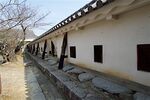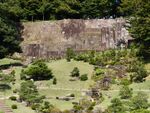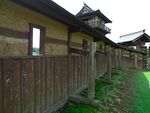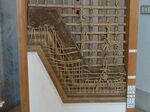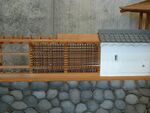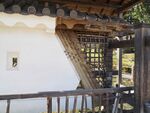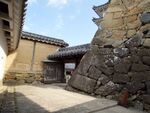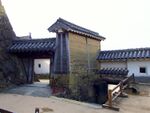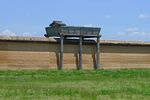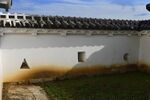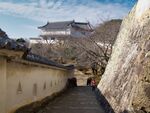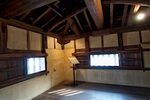Loading map...
{"format":"leaflet","minzoom":false,"maxzoom":false,"limit":500,"offset":0,"link":"all","sort":[""],"order":[],"headers":"show","mainlabel":"","intro":"","outro":"","searchlabel":"... further results","default":"","import-annotation":false,"width":"auto","height":"600px","centre":false,"title":"","label":"","icon":"Darkgreen18.png","lines":[],"polygons":[],"circles":[],"rectangles":[],"copycoords":false,"static":false,"zoom":false,"defzoom":14,"layers":["Esri.WorldTopoMap"],"image layers":[],"overlays":[],"resizable":false,"fullscreen":false,"scrollwheelzoom":true,"cluster":false,"clustermaxzoom":20,"clusterzoomonclick":true,"clustermaxradius":80,"clusterspiderfy":true,"geojson":"","clicktarget":"","showtitle":true,"hidenamespace":true,"template":"","userparam":"","activeicon":"","pagelabel":false,"ajaxcoordproperty":"","ajaxquery":"","locations":[{"text":"\u003Cb\u003E\u003Ca href=\"/view/Aizu_Wakamatsu_Castle\" title=\"Aizu Wakamatsu Castle\"\u003EAizu Wakamatsu Castle\u003C/a\u003E\u003C/b\u003E","title":"Aizu Wakamatsu Castle","link":"","lat":37.48777,"lon":139.9299,"icon":"../images/d/db/Darkgreen18.png"},{"text":"\u003Cb\u003E\u003Ca href=\"/view/Akashi_Castle\" title=\"Akashi Castle\"\u003EAkashi Castle\u003C/a\u003E\u003C/b\u003E","title":"Akashi Castle","link":"","lat":34.65231,"lon":134.99186,"icon":"../images/d/db/Darkgreen18.png"},{"text":"\u003Cb\u003E\u003Ca href=\"/view/Akechi_Jin%27ya\" title=\"Akechi Jin\u0026#039;ya\"\u003EAkechi Jin'ya\u003C/a\u003E\u003C/b\u003E","title":"Akechi Jin'ya","link":"","lat":35.30469,"lon":137.39176,"icon":"../images/d/db/Darkgreen18.png"},{"text":"\u003Cb\u003E\u003Ca href=\"/view/Akechi_Osayama_Castle\" title=\"Akechi Osayama Castle\"\u003EAkechi Osayama Castle\u003C/a\u003E\u003C/b\u003E","title":"Akechi Osayama Castle","link":"","lat":35.42205,"lon":137.08468,"icon":"../images/d/db/Darkgreen18.png"},{"text":"\u003Cb\u003E\u003Ca href=\"/view/Akita_Castle\" title=\"Akita Castle\"\u003EAkita Castle\u003C/a\u003E\u003C/b\u003E","title":"Akita Castle","link":"","lat":39.74039,"lon":140.07969,"icon":"../images/d/db/Darkgreen18.png"},{"text":"\u003Cb\u003E\u003Ca href=\"/view/Akizuki_Castle\" title=\"Akizuki Castle\"\u003EAkizuki Castle\u003C/a\u003E\u003C/b\u003E","title":"Akizuki Castle","link":"","lat":33.46607,"lon":130.69543,"icon":"../images/d/db/Darkgreen18.png"},{"text":"\u003Cb\u003E\u003Ca href=\"/view/Ako_Castle\" title=\"Ako Castle\"\u003EAko Castle\u003C/a\u003E\u003C/b\u003E","title":"Ako Castle","link":"","lat":34.74613,"lon":134.38869,"icon":"../images/d/db/Darkgreen18.png"},{"text":"\u003Cb\u003E\u003Ca href=\"/view/Amaga_Castle\" title=\"Amaga Castle\"\u003EAmaga Castle\u003C/a\u003E\u003C/b\u003E","title":"Amaga Castle","link":"","lat":31.96124,"lon":131.29356,"icon":"../images/d/db/Darkgreen18.png"},{"text":"\u003Cb\u003E\u003Ca href=\"/view/Amagasaki_Castle\" title=\"Amagasaki Castle\"\u003EAmagasaki Castle\u003C/a\u003E\u003C/b\u003E","title":"Amagasaki Castle","link":"","lat":34.71711,"lon":135.41852,"icon":"../images/d/db/Darkgreen18.png"},{"text":"\u003Cb\u003E\u003Ca href=\"/view/Aoyagi_Castle\" title=\"Aoyagi Castle\"\u003EAoyagi Castle\u003C/a\u003E\u003C/b\u003E","title":"Aoyagi Castle","link":"","lat":36.43089,"lon":138.03387,"icon":"../images/d/db/Darkgreen18.png"},{"text":"\u003Cb\u003E\u003Ca href=\"/view/Ashinoya_Jin%27ya\" title=\"Ashinoya Jin\u0026#039;ya\"\u003EAshinoya Jin'ya\u003C/a\u003E\u003C/b\u003E","title":"Ashinoya Jin'ya","link":"","lat":34.85829,"lon":137.16873,"icon":"../images/d/db/Darkgreen18.png"},{"text":"\u003Cb\u003E\u003Ca href=\"/view/Asuke_Castle\" title=\"Asuke Castle\"\u003EAsuke Castle\u003C/a\u003E\u003C/b\u003E","title":"Asuke Castle","link":"","lat":35.13447,"lon":137.32534,"icon":"../images/d/db/Darkgreen18.png"},{"text":"\u003Cb\u003E\u003Ca href=\"/view/Baba_Yashiki\" title=\"Baba Yashiki\"\u003EBaba Yashiki\u003C/a\u003E\u003C/b\u003E","title":"Baba Yashiki","link":"","lat":36.16734,"lon":137.98551,"icon":"../images/d/db/Darkgreen18.png"},{"text":"\u003Cb\u003E\u003Ca href=\"/view/Bitchu_Matsuyama_Castle\" title=\"Bitchu Matsuyama Castle\"\u003EBitchu Matsuyama Castle\u003C/a\u003E\u003C/b\u003E","title":"Bitchu Matsuyama Castle","link":"","lat":34.80891,"lon":133.62219,"icon":"../images/d/db/Darkgreen18.png"},{"text":"\u003Cb\u003E\u003Ca href=\"/view/Echizen_Katsuyama_Castle\" title=\"Echizen Katsuyama Castle\"\u003EEchizen Katsuyama Castle\u003C/a\u003E\u003C/b\u003E","title":"Echizen Katsuyama Castle","link":"","lat":36.06083,"lon":136.50052,"icon":"../images/d/db/Darkgreen18.png"},{"text":"\u003Cb\u003E\u003Ca href=\"/view/Edo_Castle\" title=\"Edo Castle\"\u003EEdo Castle\u003C/a\u003E\u003C/b\u003E","title":"Edo Castle","link":"","lat":35.68824,"lon":139.75432,"icon":"../images/d/db/Darkgreen18.png"},{"text":"\u003Cb\u003E\u003Ca href=\"/view/Ema_Yakata\" title=\"Ema Yakata\"\u003EEma Yakata\u003C/a\u003E\u003C/b\u003E","title":"Ema Yakata","link":"","lat":36.32622,"lon":137.30951,"icon":"../images/d/db/Darkgreen18.png"},{"text":"\u003Cb\u003E\u003Ca href=\"/view/Fukuchiyama_Castle\" title=\"Fukuchiyama Castle\"\u003EFukuchiyama Castle\u003C/a\u003E\u003C/b\u003E","title":"Fukuchiyama Castle","link":"","lat":35.2968,"lon":135.12952,"icon":"../images/d/db/Darkgreen18.png"},{"text":"\u003Cb\u003E\u003Ca href=\"/view/Fukui_Castle\" title=\"Fukui Castle\"\u003EFukui Castle\u003C/a\u003E\u003C/b\u003E","title":"Fukui Castle","link":"","lat":36.06495,"lon":136.22184,"icon":"../images/d/db/Darkgreen18.png"},{"text":"\u003Cb\u003E\u003Ca href=\"/view/Fukuyama_Castle\" title=\"Fukuyama Castle\"\u003EFukuyama Castle\u003C/a\u003E\u003C/b\u003E","title":"Fukuyama Castle","link":"","lat":34.49103,"lon":133.36112,"icon":"../images/d/db/Darkgreen18.png"},{"text":"\u003Cb\u003E\u003Ca href=\"/view/Funai_Castle\" title=\"Funai Castle\"\u003EFunai Castle\u003C/a\u003E\u003C/b\u003E","title":"Funai Castle","link":"","lat":33.24064,"lon":131.61143,"icon":"../images/d/db/Darkgreen18.png"},{"text":"\u003Cb\u003E\u003Ca href=\"/view/Fushimi_Castle\" title=\"Fushimi Castle\"\u003EFushimi Castle\u003C/a\u003E\u003C/b\u003E","title":"Fushimi Castle","link":"","lat":34.94123,"lon":135.77915,"icon":"../images/d/db/Darkgreen18.png"},{"text":"\u003Cb\u003E\u003Ca href=\"/view/Ganjaku_Castle\" title=\"Ganjaku Castle\"\u003EGanjaku Castle\u003C/a\u003E\u003C/b\u003E","title":"Ganjaku Castle","link":"","lat":33.57136,"lon":130.86415,"icon":"../images/d/db/Darkgreen18.png"},{"text":"\u003Cb\u003E\u003Ca href=\"/view/Gujo_Hachiman_Castle\" title=\"Gujo Hachiman Castle\"\u003EGujo Hachiman Castle\u003C/a\u003E\u003C/b\u003E","title":"Gujo Hachiman Castle","link":"","lat":35.75308,"lon":136.96136,"icon":"../images/d/db/Darkgreen18.png"},{"text":"\u003Cb\u003E\u003Ca href=\"/view/Ha_Castle\" title=\"Ha Castle\"\u003EHa Castle\u003C/a\u003E\u003C/b\u003E","title":"Ha Castle","link":"","lat":34.8774,"lon":136.98434,"icon":"../images/d/db/Darkgreen18.png"},{"text":"\u003Cb\u003E\u003Ca href=\"/view/Hachigata_Castle\" title=\"Hachigata Castle\"\u003EHachigata Castle\u003C/a\u003E\u003C/b\u003E","title":"Hachigata Castle","link":"","lat":36.10724,"lon":139.19362,"icon":"../images/d/db/Darkgreen18.png"},{"text":"\u003Cb\u003E\u003Ca href=\"/view/Hagi_Castle\" title=\"Hagi Castle\"\u003EHagi Castle\u003C/a\u003E\u003C/b\u003E","title":"Hagi Castle","link":"","lat":34.41767,"lon":131.38344,"icon":"../images/d/db/Darkgreen18.png"},{"text":"\u003Cb\u003E\u003Ca href=\"/view/Hamamatsu_Castle\" title=\"Hamamatsu Castle\"\u003EHamamatsu Castle\u003C/a\u003E\u003C/b\u003E","title":"Hamamatsu Castle","link":"","lat":34.71174,"lon":137.72479,"icon":"../images/d/db/Darkgreen18.png"},{"text":"\u003Cb\u003E\u003Ca href=\"/view/Hanamaki_Castle\" title=\"Hanamaki Castle\"\u003EHanamaki Castle\u003C/a\u003E\u003C/b\u003E","title":"Hanamaki Castle","link":"","lat":39.39169,"lon":141.12027,"icon":"../images/d/db/Darkgreen18.png"},{"text":"\u003Cb\u003E\u003Ca href=\"/view/Hikone_Castle\" title=\"Hikone Castle\"\u003EHikone Castle\u003C/a\u003E\u003C/b\u003E","title":"Hikone Castle","link":"","lat":35.27649,"lon":136.25174,"icon":"../images/d/db/Darkgreen18.png"},{"text":"\u003Cb\u003E\u003Ca href=\"/view/Himeji_Castle\" title=\"Himeji Castle\"\u003EHimeji Castle\u003C/a\u003E\u003C/b\u003E","title":"Himeji Castle","link":"","lat":34.83806,"lon":134.69348,"icon":"../images/d/db/Darkgreen18.png"},{"text":"\u003Cb\u003E\u003Ca href=\"/view/Hiraizumi_Date\" title=\"Hiraizumi Date\"\u003EHiraizumi Date\u003C/a\u003E\u003C/b\u003E","title":"Hiraizumi Date","link":"","lat":38.99369,"lon":141.11966,"icon":"../images/d/db/Darkgreen18.png"},{"text":"\u003Cb\u003E\u003Ca href=\"/view/Hirosaki_Castle\" title=\"Hirosaki Castle\"\u003EHirosaki Castle\u003C/a\u003E\u003C/b\u003E","title":"Hirosaki Castle","link":"","lat":40.60783,"lon":140.46533,"icon":"../images/d/db/Darkgreen18.png"},{"text":"\u003Cb\u003E\u003Ca href=\"/view/Hiroshima_Castle\" title=\"Hiroshima Castle\"\u003EHiroshima Castle\u003C/a\u003E\u003C/b\u003E","title":"Hiroshima Castle","link":"","lat":34.40272,"lon":132.45888,"icon":"../images/d/db/Darkgreen18.png"},{"text":"\u003Cb\u003E\u003Ca href=\"/view/Honshouji_Castle\" title=\"Honshouji Castle\"\u003EHonshouji Castle\u003C/a\u003E\u003C/b\u003E","title":"Honshouji Castle","link":"","lat":34.90013,"lon":137.08596,"icon":"../images/d/db/Darkgreen18.png"},{"text":"\u003Cb\u003E\u003Ca href=\"/view/Hotta_no_Saku\" title=\"Hotta no Saku\"\u003EHotta no Saku\u003C/a\u003E\u003C/b\u003E","title":"Hotta no Saku","link":"","lat":39.46532,"lon":140.54775,"icon":"../images/d/db/Darkgreen18.png"},{"text":"\u003Cb\u003E\u003Ca href=\"/view/Ichijodani_Castle\" title=\"Ichijodani Castle\"\u003EIchijodani Castle\u003C/a\u003E\u003C/b\u003E","title":"Ichijodani Castle","link":"","lat":36.00904,"lon":136.30068,"icon":"../images/d/db/Darkgreen18.png"},{"text":"\u003Cb\u003E\u003Ca href=\"/view/Ide_Yakata\" title=\"Ide Yakata\"\u003EIde Yakata\u003C/a\u003E\u003C/b\u003E","title":"Ide Yakata","link":"","lat":35.30146,"lon":138.58804,"icon":"../images/d/db/Darkgreen18.png"},{"text":"\u003Cb\u003E\u003Ca href=\"/view/Iga_Ueno_Castle\" title=\"Iga Ueno Castle\"\u003EIga Ueno Castle\u003C/a\u003E\u003C/b\u003E","title":"Iga Ueno Castle","link":"","lat":34.77013,"lon":136.1271,"icon":"../images/d/db/Darkgreen18.png"},{"text":"\u003Cb\u003E\u003Ca href=\"/view/Iida_Castle\" title=\"Iida Castle\"\u003EIida Castle\u003C/a\u003E\u003C/b\u003E","title":"Iida Castle","link":"","lat":35.51212,"lon":137.83183,"icon":"../images/d/db/Darkgreen18.png"},{"text":"\u003Cb\u003E\u003Ca href=\"/view/Iijima_Jin%27ya\" title=\"Iijima Jin\u0026#039;ya\"\u003EIijima Jin'ya\u003C/a\u003E\u003C/b\u003E","title":"Iijima Jin'ya","link":"","lat":35.68022,"lon":137.92527,"icon":"../images/d/db/Darkgreen18.png"},{"text":"\u003Cb\u003E\u003Ca href=\"/view/Iji_Castle\" title=\"Iji Castle\"\u003EIji Castle\u003C/a\u003E\u003C/b\u003E","title":"Iji Castle","link":"","lat":38.76536,"lon":141.03766,"icon":"../images/d/db/Darkgreen18.png"},{"text":"\u003Cb\u003E\u003Ca href=\"/view/Ikeda_Castle\" title=\"Ikeda Castle\"\u003EIkeda Castle\u003C/a\u003E\u003C/b\u003E","title":"Ikeda Castle","link":"","lat":34.8268,"lon":135.42811,"icon":"../images/d/db/Darkgreen18.png"},{"text":"\u003Cb\u003E\u003Ca href=\"/view/Imabari_Castle\" title=\"Imabari Castle\"\u003EImabari Castle\u003C/a\u003E\u003C/b\u003E","title":"Imabari Castle","link":"","lat":34.06305,"lon":133.00667,"icon":"../images/d/db/Darkgreen18.png"},{"text":"\u003Cb\u003E\u003Ca href=\"/view/Inuyama_Castle\" title=\"Inuyama Castle\"\u003EInuyama Castle\u003C/a\u003E\u003C/b\u003E","title":"Inuyama Castle","link":"","lat":35.38835,"lon":136.93917,"icon":"../images/d/db/Darkgreen18.png"},{"text":"\u003Cb\u003E\u003Ca href=\"/view/Ishikawa_Jouzan_Yashiki\" title=\"Ishikawa Jouzan Yashiki\"\u003EIshikawa Jouzan Yashiki\u003C/a\u003E\u003C/b\u003E","title":"Ishikawa Jouzan Yashiki","link":"","lat":34.92026,"lon":137.04634,"icon":"../images/d/db/Darkgreen18.png"},{"text":"\u003Cb\u003E\u003Ca href=\"/view/Iwamura_Castle\" title=\"Iwamura Castle\"\u003EIwamura Castle\u003C/a\u003E\u003C/b\u003E","title":"Iwamura Castle","link":"","lat":35.35993,"lon":137.45102,"icon":"../images/d/db/Darkgreen18.png"},{"text":"\u003Cb\u003E\u003Ca href=\"/view/Iyo_Matsuyama_Castle\" title=\"Iyo Matsuyama Castle\"\u003EIyo Matsuyama Castle\u003C/a\u003E\u003C/b\u003E","title":"Iyo Matsuyama Castle","link":"","lat":33.84526,"lon":132.76575,"icon":"../images/d/db/Darkgreen18.png"},{"text":"\u003Cb\u003E\u003Ca href=\"/view/Izuki_Jin%27ya\" title=\"Izuki Jin\u0026#039;ya\"\u003EIzuki Jin'ya\u003C/a\u003E\u003C/b\u003E","title":"Izuki Jin'ya","link":"","lat":35.44618,"lon":137.7951,"icon":"../images/d/db/Darkgreen18.png"},{"text":"\u003Cb\u003E\u003Ca href=\"/view/Izushi_Castle\" title=\"Izushi Castle\"\u003EIzushi Castle\u003C/a\u003E\u003C/b\u003E","title":"Izushi Castle","link":"","lat":35.46025,"lon":134.87445,"icon":"../images/d/db/Darkgreen18.png"},{"text":"\u003Cb\u003E\u003Ca href=\"/view/Kakegawa_Castle\" title=\"Kakegawa Castle\"\u003EKakegawa Castle\u003C/a\u003E\u003C/b\u003E","title":"Kakegawa Castle","link":"","lat":34.77546,"lon":138.01486,"icon":"../images/d/db/Darkgreen18.png"},{"text":"\u003Cb\u003E\u003Ca href=\"/view/Kameyama_Castle\" title=\"Kameyama Castle\"\u003EKameyama Castle\u003C/a\u003E\u003C/b\u003E","title":"Kameyama Castle","link":"","lat":34.85617,"lon":136.45056,"icon":"../images/d/db/Darkgreen18.png"},{"text":"\u003Cb\u003E\u003Ca href=\"/view/Kaminoyama_Castle\" title=\"Kaminoyama Castle\"\u003EKaminoyama Castle\u003C/a\u003E\u003C/b\u003E","title":"Kaminoyama Castle","link":"","lat":38.15786,"lon":140.27592,"icon":"../images/d/db/Darkgreen18.png"},{"text":"\u003Cb\u003E\u003Ca href=\"/view/Kamioka_Castle\" title=\"Kamioka Castle\"\u003EKamioka Castle\u003C/a\u003E\u003C/b\u003E","title":"Kamioka Castle","link":"","lat":36.32991,"lon":137.30232,"icon":"../images/d/db/Darkgreen18.png"},{"text":"\u003Cb\u003E\u003Ca href=\"/view/Kanazawa_Castle\" title=\"Kanazawa Castle\"\u003EKanazawa Castle\u003C/a\u003E\u003C/b\u003E","title":"Kanazawa Castle","link":"","lat":36.56549,"lon":136.65928,"icon":"../images/d/db/Darkgreen18.png"},{"text":"\u003Cb\u003E\u003Ca href=\"/view/Kashima_Castle_(Hizen)\" title=\"Kashima Castle (Hizen)\"\u003EKashima Castle (Hizen)\u003C/a\u003E\u003C/b\u003E","title":"Kashima Castle (Hizen)","link":"","lat":33.10399,"lon":130.09348,"icon":"../images/d/db/Darkgreen18.png"},{"text":"\u003Cb\u003E\u003Ca href=\"/view/Katsumoto_Castle\" title=\"Katsumoto Castle\"\u003EKatsumoto Castle\u003C/a\u003E\u003C/b\u003E","title":"Katsumoto Castle","link":"","lat":33.84938,"lon":129.69113,"icon":"../images/d/db/Darkgreen18.png"},{"text":"\u003Cb\u003E\u003Ca href=\"/view/Kawahara_Castle\" title=\"Kawahara Castle\"\u003EKawahara Castle\u003C/a\u003E\u003C/b\u003E","title":"Kawahara Castle","link":"","lat":35.40382,"lon":134.19949,"icon":"../images/d/db/Darkgreen18.png"},{"text":"\u003Cb\u003E\u003Ca href=\"/view/Kawajiri_Castle\" title=\"Kawajiri Castle\"\u003EKawajiri Castle\u003C/a\u003E\u003C/b\u003E","title":"Kawajiri Castle","link":"","lat":34.98152,"lon":137.42912,"icon":"../images/d/db/Darkgreen18.png"},{"text":"\u003Cb\u003E\u003Ca href=\"/view/Kawasaki_no_Saku\" title=\"Kawasaki no Saku\"\u003EKawasaki no Saku\u003C/a\u003E\u003C/b\u003E","title":"Kawasaki no Saku","link":"","lat":38.90475,"lon":141.25291,"icon":"../images/d/db/Darkgreen18.png"},{"text":"\u003Cb\u003E\u003Ca href=\"/view/Kinowa_Castle\" title=\"Kinowa Castle\"\u003EKinowa Castle\u003C/a\u003E\u003C/b\u003E","title":"Kinowa Castle","link":"","lat":38.96373,"lon":139.90926,"icon":"../images/d/db/Darkgreen18.png"},{"text":"\u003Cb\u003E\u003Ca href=\"/view/Kishiwada_Castle\" title=\"Kishiwada Castle\"\u003EKishiwada Castle\u003C/a\u003E\u003C/b\u003E","title":"Kishiwada Castle","link":"","lat":34.45896,"lon":135.37066,"icon":"../images/d/db/Darkgreen18.png"},{"text":"\u003Cb\u003E\u003Ca href=\"/view/Kiyosu_Castle\" title=\"Kiyosu Castle\"\u003EKiyosu Castle\u003C/a\u003E\u003C/b\u003E","title":"Kiyosu Castle","link":"","lat":35.21655,"lon":136.84351,"icon":"../images/d/db/Darkgreen18.png"},{"text":"\u003Cb\u003E\u003Ca href=\"/view/Kobayashi_Castle_(Owari)\" title=\"Kobayashi Castle (Owari)\"\u003EKobayashi Castle (Owari)\u003C/a\u003E\u003C/b\u003E","title":"Kobayashi Castle (Owari)","link":"","lat":35.16133,"lon":136.9075,"icon":"../images/d/db/Darkgreen18.png"},{"text":"\u003Cb\u003E\u003Ca href=\"/view/Kofu_Castle\" title=\"Kofu Castle\"\u003EKofu Castle\u003C/a\u003E\u003C/b\u003E","title":"Kofu Castle","link":"","lat":35.66535,"lon":138.57092,"icon":"../images/d/db/Darkgreen18.png"},{"text":"\u003Cb\u003E\u003Ca href=\"/view/Koiwatake_Castle\" title=\"Koiwatake Castle\"\u003EKoiwatake Castle\u003C/a\u003E\u003C/b\u003E","title":"Koiwatake Castle","link":"","lat":36.35485,"lon":137.83512,"icon":"../images/d/db/Darkgreen18.png"},{"text":"\u003Cb\u003E\u003Ca href=\"/view/Kokura_Castle\" title=\"Kokura Castle\"\u003EKokura Castle\u003C/a\u003E\u003C/b\u003E","title":"Kokura Castle","link":"","lat":33.88442,"lon":130.87426,"icon":"../images/d/db/Darkgreen18.png"},{"text":"\u003Cb\u003E\u003Ca href=\"/view/Kozuka_Jin%27ya\" title=\"Kozuka Jin\u0026#039;ya\"\u003EKozuka Jin'ya\u003C/a\u003E\u003C/b\u003E","title":"Kozuka Jin'ya","link":"","lat":35.18549,"lon":138.67942,"icon":"../images/d/db/Darkgreen18.png"},{"text":"\u003Cb\u003E\u003Ca href=\"/view/Kumamoto_Castle\" title=\"Kumamoto Castle\"\u003EKumamoto Castle\u003C/a\u003E\u003C/b\u003E","title":"Kumamoto Castle","link":"","lat":32.80617,"lon":130.70573,"icon":"../images/d/db/Darkgreen18.png"},{"text":"\u003Cb\u003E\u003Ca href=\"/view/Kuriyagawa_no_Saku\" title=\"Kuriyagawa no Saku\"\u003EKuriyagawa no Saku\u003C/a\u003E\u003C/b\u003E","title":"Kuriyagawa no Saku","link":"","lat":39.71168,"lon":141.12139,"icon":"../images/d/db/Darkgreen18.png"},{"text":"\u003Cb\u003E\u003Ca href=\"/view/Kyara_Palace\" title=\"Kyara Palace\"\u003EKyara Palace\u003C/a\u003E\u003C/b\u003E","title":"Kyara Palace","link":"","lat":38.99103,"lon":141.11816,"icon":"../images/d/db/Darkgreen18.png"},{"text":"\u003Cb\u003E\u003Ca href=\"/view/Marugame_Castle\" title=\"Marugame Castle\"\u003EMarugame Castle\u003C/a\u003E\u003C/b\u003E","title":"Marugame Castle","link":"","lat":34.28608,"lon":133.80043,"icon":"../images/d/db/Darkgreen18.png"},{"text":"\u003Cb\u003E\u003Ca href=\"/view/Maruoka_Castle\" title=\"Maruoka Castle\"\u003EMaruoka Castle\u003C/a\u003E\u003C/b\u003E","title":"Maruoka Castle","link":"","lat":36.15236,"lon":136.27211,"icon":"../images/d/db/Darkgreen18.png"},{"text":"\u003Cb\u003E\u003Ca href=\"/view/Matsue_Castle\" title=\"Matsue Castle\"\u003EMatsue Castle\u003C/a\u003E\u003C/b\u003E","title":"Matsue Castle","link":"","lat":35.47522,"lon":133.04985,"icon":"../images/d/db/Darkgreen18.png"},{"text":"\u003Cb\u003E\u003Ca href=\"/view/Matsumae_Castle\" title=\"Matsumae Castle\"\u003EMatsumae Castle\u003C/a\u003E\u003C/b\u003E","title":"Matsumae Castle","link":"","lat":41.42987,"lon":140.10844,"icon":"../images/d/db/Darkgreen18.png"},{"text":"\u003Cb\u003E\u003Ca href=\"/view/Matsumoto_Castle\" title=\"Matsumoto Castle\"\u003EMatsumoto Castle\u003C/a\u003E\u003C/b\u003E","title":"Matsumoto Castle","link":"","lat":36.23864,"lon":137.96892,"icon":"../images/d/db/Darkgreen18.png"},{"text":"\u003Cb\u003E\u003Ca href=\"/view/Matsushiro_Castle\" title=\"Matsushiro Castle\"\u003EMatsushiro Castle\u003C/a\u003E\u003C/b\u003E","title":"Matsushiro Castle","link":"","lat":36.56596,"lon":138.19598,"icon":"../images/d/db/Darkgreen18.png"},{"text":"\u003Cb\u003E\u003Ca href=\"/view/Mikazuki_Jin%27ya\" title=\"Mikazuki Jin\u0026#039;ya\"\u003EMikazuki Jin'ya\u003C/a\u003E\u003C/b\u003E","title":"Mikazuki Jin'ya","link":"","lat":34.99084,"lon":134.43125,"icon":"../images/d/db/Darkgreen18.png"},{"text":"\u003Cb\u003E\u003Ca href=\"/view/Miki_Castle\" title=\"Miki Castle\"\u003EMiki Castle\u003C/a\u003E\u003C/b\u003E","title":"Miki Castle","link":"","lat":34.79988,"lon":134.98786,"icon":"../images/d/db/Darkgreen18.png"},{"text":"\u003Cb\u003E\u003Ca href=\"/view/Minakuchi_Castle\" title=\"Minakuchi Castle\"\u003EMinakuchi Castle\u003C/a\u003E\u003C/b\u003E","title":"Minakuchi Castle","link":"","lat":34.97023,"lon":136.16547,"icon":"../images/d/db/Darkgreen18.png"},{"text":"\u003Cb\u003E\u003Ca href=\"/view/Mito_Castle\" title=\"Mito Castle\"\u003EMito Castle\u003C/a\u003E\u003C/b\u003E","title":"Mito Castle","link":"","lat":36.37286,"lon":140.4828,"icon":"../images/d/db/Darkgreen18.png"},{"text":"\u003Cb\u003E\u003Ca href=\"/view/Nabari_Jinya\" title=\"Nabari Jinya\"\u003ENabari Jinya\u003C/a\u003E\u003C/b\u003E","title":"Nabari Jinya","link":"","lat":34.62235,"lon":136.09109,"icon":"../images/d/db/Darkgreen18.png"},{"text":"\u003Cb\u003E\u003Ca href=\"/view/Nabebuta_Castle\" title=\"Nabebuta Castle\"\u003ENabebuta Castle\u003C/a\u003E\u003C/b\u003E","title":"Nabebuta Castle","link":"","lat":36.3296,"lon":138.42152,"icon":"../images/d/db/Darkgreen18.png"},{"text":"\u003Cb\u003E\u003Ca href=\"/view/Nagata_Jin%27ya\" title=\"Nagata Jin\u0026#039;ya\"\u003ENagata Jin'ya\u003C/a\u003E\u003C/b\u003E","title":"Nagata Jin'ya","link":"","lat":35.9057,"lon":139.5737,"icon":"../images/d/db/Darkgreen18.png"},{"text":"\u003Cb\u003E\u003Ca href=\"/view/Nagisa_Castle\" title=\"Nagisa Castle\"\u003ENagisa Castle\u003C/a\u003E\u003C/b\u003E","title":"Nagisa Castle","link":"","lat":36.23149,"lon":137.95756,"icon":"../images/d/db/Darkgreen18.png"},{"text":"\u003Cb\u003E\u003Ca href=\"/view/Nagoya_Castle\" title=\"Nagoya Castle\"\u003ENagoya Castle\u003C/a\u003E\u003C/b\u003E","title":"Nagoya Castle","link":"","lat":35.18555,"lon":136.89898,"icon":"../images/d/db/Darkgreen18.png"},{"text":"\u003Cb\u003E\u003Ca href=\"/view/Nakatsu_Castle\" title=\"Nakatsu Castle\"\u003ENakatsu Castle\u003C/a\u003E\u003C/b\u003E","title":"Nakatsu Castle","link":"","lat":33.60664,"lon":131.18643,"icon":"../images/d/db/Darkgreen18.png"},{"text":"\u003Cb\u003E\u003Ca href=\"/view/Nakoso_no_Seki\" title=\"Nakoso no Seki\"\u003ENakoso no Seki\u003C/a\u003E\u003C/b\u003E","title":"Nakoso no Seki","link":"","lat":36.86578,"lon":140.78014,"icon":"../images/d/db/Darkgreen18.png"},{"text":"\u003Cb\u003E\u003Ca href=\"/view/Nanokaichi_Jin%27ya\" title=\"Nanokaichi Jin\u0026#039;ya\"\u003ENanokaichi Jin'ya\u003C/a\u003E\u003C/b\u003E","title":"Nanokaichi Jin'ya","link":"","lat":36.25711,"lon":138.87497,"icon":"../images/d/db/Darkgreen18.png"},{"text":"\u003Cb\u003E\u003Ca href=\"/view/Ne_Castle\" title=\"Ne Castle\"\u003ENe Castle\u003C/a\u003E\u003C/b\u003E","title":"Ne Castle","link":"","lat":40.5062,"lon":141.46042,"icon":"../images/d/db/Darkgreen18.png"},{"text":"\u003Cb\u003E\u003Ca href=\"/view/Nihonmatsu_Castle\" title=\"Nihonmatsu Castle\"\u003ENihonmatsu Castle\u003C/a\u003E\u003C/b\u003E","title":"Nihonmatsu Castle","link":"","lat":37.59976,"lon":140.4281,"icon":"../images/d/db/Darkgreen18.png"},{"text":"\u003Cb\u003E\u003Ca href=\"/view/Nijo_Castle\" title=\"Nijo Castle\"\u003ENijo Castle\u003C/a\u003E\u003C/b\u003E","title":"Nijo Castle","link":"","lat":35.01406,"lon":135.74769,"icon":"../images/d/db/Darkgreen18.png"},{"text":"\u003Cb\u003E\u003Ca href=\"/view/Nishio_Castle\" title=\"Nishio Castle\"\u003ENishio Castle\u003C/a\u003E\u003C/b\u003E","title":"Nishio Castle","link":"","lat":34.86631,"lon":137.04804,"icon":"../images/d/db/Darkgreen18.png"},{"text":"\u003Cb\u003E\u003Ca href=\"/view/Nishiohhira_Jin%27ya\" title=\"Nishiohhira Jin\u0026#039;ya\"\u003ENishiohhira Jin'ya\u003C/a\u003E\u003C/b\u003E","title":"Nishiohhira Jin'ya","link":"","lat":34.94036,"lon":137.19589,"icon":"../images/d/db/Darkgreen18.png"},{"text":"\u003Cb\u003E\u003Ca href=\"/view/Noda_Castle_(Shitara)\" title=\"Noda Castle (Shitara)\"\u003ENoda Castle (Shitara)\u003C/a\u003E\u003C/b\u003E","title":"Noda Castle (Shitara)","link":"","lat":34.88187,"lon":137.46865,"icon":"../images/d/db/Darkgreen18.png"},{"text":"\u003Cb\u003E\u003Ca href=\"/view/Obata_Jin%27ya\" title=\"Obata Jin\u0026#039;ya\"\u003EObata Jin'ya\u003C/a\u003E\u003C/b\u003E","title":"Obata Jin'ya","link":"","lat":36.22835,"lon":138.91468,"icon":"../images/d/db/Darkgreen18.png"},{"text":"\u003Cb\u003E\u003Ca href=\"/view/Obi_Castle\" title=\"Obi Castle\"\u003EObi Castle\u003C/a\u003E\u003C/b\u003E","title":"Obi Castle","link":"","lat":31.62911,"lon":131.3503,"icon":"../images/d/db/Darkgreen18.png"},{"text":"\u003Cb\u003E\u003Ca href=\"/view/Odawara_Castle\" title=\"Odawara Castle\"\u003EOdawara Castle\u003C/a\u003E\u003C/b\u003E","title":"Odawara Castle","link":"","lat":35.25086,"lon":139.1539,"icon":"../images/d/db/Darkgreen18.png"},{"text":"\u003Cb\u003E\u003Ca href=\"/view/Ogaki_Castle\" title=\"Ogaki Castle\"\u003EOgaki Castle\u003C/a\u003E\u003C/b\u003E","title":"Ogaki Castle","link":"","lat":35.36197,"lon":136.61598,"icon":"../images/d/db/Darkgreen18.png"},{"text":"\u003Cb\u003E\u003Ca href=\"/view/Oguchi_Castle\" title=\"Oguchi Castle\"\u003EOguchi Castle\u003C/a\u003E\u003C/b\u003E","title":"Oguchi Castle","link":"","lat":35.34112,"lon":136.91613,"icon":"../images/d/db/Darkgreen18.png"},{"text":"\u003Cb\u003E\u003Ca href=\"/view/Ogurayama_Castle\" title=\"Ogurayama Castle\"\u003EOgurayama Castle\u003C/a\u003E\u003C/b\u003E","title":"Ogurayama Castle","link":"","lat":35.55059,"lon":136.9109,"icon":"../images/d/db/Darkgreen18.png"},{"text":"\u003Cb\u003E\u003Ca href=\"/view/Ohmine_Castle\" title=\"Ohmine Castle\"\u003EOhmine Castle\u003C/a\u003E\u003C/b\u003E","title":"Ohmine Castle","link":"","lat":36.67569,"lon":138.17692,"icon":"../images/d/db/Darkgreen18.png"},{"text":"\u003Cb\u003E\u003Ca href=\"/view/Ohmori_Daikansho\" title=\"Ohmori Daikansho\"\u003EOhmori Daikansho\u003C/a\u003E\u003C/b\u003E","title":"Ohmori Daikansho","link":"","lat":35.12194,"lon":132.44803,"icon":"../images/d/db/Darkgreen18.png"},{"text":"\u003Cb\u003E\u003Ca href=\"/view/Ohtsuka_Moated_Settlement\" title=\"Ohtsuka Moated Settlement\"\u003EOhtsuka Moated Settlement\u003C/a\u003E\u003C/b\u003E","title":"Ohtsuka Moated Settlement","link":"","lat":35.55157,"lon":139.58063,"icon":"../images/d/db/Darkgreen18.png"},{"text":"\u003Cb\u003E\u003Ca href=\"/view/Okayama_Castle\" title=\"Okayama Castle\"\u003EOkayama Castle\u003C/a\u003E\u003C/b\u003E","title":"Okayama Castle","link":"","lat":34.66516,"lon":133.93606,"icon":"../images/d/db/Darkgreen18.png"},{"text":"\u003Cb\u003E\u003Ca href=\"/view/Okutono_Jin%27ya\" title=\"Okutono Jin\u0026#039;ya\"\u003EOkutono Jin'ya\u003C/a\u003E\u003C/b\u003E","title":"Okutono Jin'ya","link":"","lat":35.02896,"lon":137.19477,"icon":"../images/d/db/Darkgreen18.png"},{"text":"\u003Cb\u003E\u003Ca href=\"/view/Osaka_Castle\" title=\"Osaka Castle\"\u003EOsaka Castle\u003C/a\u003E\u003C/b\u003E","title":"Osaka Castle","link":"","lat":34.68739,"lon":135.52575,"icon":"../images/d/db/Darkgreen18.png"},{"text":"\u003Cb\u003E\u003Ca href=\"/view/Oshi_Castle\" title=\"Oshi Castle\"\u003EOshi Castle\u003C/a\u003E\u003C/b\u003E","title":"Oshi Castle","link":"","lat":36.13777,"lon":139.45398,"icon":"../images/d/db/Darkgreen18.png"},{"text":"\u003Cb\u003E\u003Ca href=\"/view/Otaki_Castle\" title=\"Otaki Castle\"\u003EOtaki Castle\u003C/a\u003E\u003C/b\u003E","title":"Otaki Castle","link":"","lat":35.28587,"lon":140.23934,"icon":"../images/d/db/Darkgreen18.png"},{"text":"\u003Cb\u003E\u003Ca href=\"/view/Saga_Castle\" title=\"Saga Castle\"\u003ESaga Castle\u003C/a\u003E\u003C/b\u003E","title":"Saga Castle","link":"","lat":33.24561,"lon":130.30253,"icon":"../images/d/db/Darkgreen18.png"},{"text":"\u003Cb\u003E\u003Ca href=\"/view/Sakasai_Castle\" title=\"Sakasai Castle\"\u003ESakasai Castle\u003C/a\u003E\u003C/b\u003E","title":"Sakasai Castle","link":"","lat":36.14203,"lon":139.85253,"icon":"../images/d/db/Darkgreen18.png"},{"text":"\u003Cb\u003E\u003Ca href=\"/view/Sannohe_Castle\" title=\"Sannohe Castle\"\u003ESannohe Castle\u003C/a\u003E\u003C/b\u003E","title":"Sannohe Castle","link":"","lat":40.38136,"lon":141.26409,"icon":"../images/d/db/Darkgreen18.png"},{"text":"\u003Cb\u003E\u003Ca href=\"/view/Sasayama_Castle\" title=\"Sasayama Castle\"\u003ESasayama Castle\u003C/a\u003E\u003C/b\u003E","title":"Sasayama Castle","link":"","lat":35.07341,"lon":135.21757,"icon":"../images/d/db/Darkgreen18.png"},{"text":"\u003Cb\u003E\u003Ca href=\"/view/Sekiyado_Castle\" title=\"Sekiyado Castle\"\u003ESekiyado Castle\u003C/a\u003E\u003C/b\u003E","title":"Sekiyado Castle","link":"","lat":36.10019,"lon":139.78227,"icon":"../images/d/db/Darkgreen18.png"},{"text":"\u003Cb\u003E\u003Ca href=\"/view/Sendai_Castle\" title=\"Sendai Castle\"\u003ESendai Castle\u003C/a\u003E\u003C/b\u003E","title":"Sendai Castle","link":"","lat":38.25266,"lon":140.85586,"icon":"../images/d/db/Darkgreen18.png"},{"text":"\u003Cb\u003E\u003Ca href=\"/view/Shibata_Castle\" title=\"Shibata Castle\"\u003EShibata Castle\u003C/a\u003E\u003C/b\u003E","title":"Shibata Castle","link":"","lat":37.95513,"lon":139.32514,"icon":"../images/d/db/Darkgreen18.png"},{"text":"\u003Cb\u003E\u003Ca href=\"/view/Shimabara_Castle\" title=\"Shimabara Castle\"\u003EShimabara Castle\u003C/a\u003E\u003C/b\u003E","title":"Shimabara Castle","link":"","lat":32.78921,"lon":130.36724,"icon":"../images/d/db/Darkgreen18.png"},{"text":"\u003Cb\u003E\u003Ca href=\"/view/Shirakawa_Castle\" title=\"Shirakawa Castle\"\u003EShirakawa Castle\u003C/a\u003E\u003C/b\u003E","title":"Shirakawa Castle","link":"","lat":37.11728,"lon":140.23432,"icon":"../images/d/db/Darkgreen18.png"},{"text":"\u003Cb\u003E\u003Ca href=\"/view/Shirakawa_Komine_Castle\" title=\"Shirakawa Komine Castle\"\u003EShirakawa Komine Castle\u003C/a\u003E\u003C/b\u003E","title":"Shirakawa Komine Castle","link":"","lat":37.1328,"lon":140.21358,"icon":"../images/d/db/Darkgreen18.png"},{"text":"\u003Cb\u003E\u003Ca href=\"/view/Shiroishi_Castle\" title=\"Shiroishi Castle\"\u003EShiroishi Castle\u003C/a\u003E\u003C/b\u003E","title":"Shiroishi Castle","link":"","lat":38.00263,"lon":140.61711,"icon":"../images/d/db/Darkgreen18.png"},{"text":"\u003Cb\u003E\u003Ca href=\"/view/Shiwa_Castle\" title=\"Shiwa Castle\"\u003EShiwa Castle\u003C/a\u003E\u003C/b\u003E","title":"Shiwa Castle","link":"","lat":39.68502,"lon":141.10608,"icon":"../images/d/db/Darkgreen18.png"},{"text":"\u003Cb\u003E\u003Ca href=\"/view/Sonobe_Castle\" title=\"Sonobe Castle\"\u003ESonobe Castle\u003C/a\u003E\u003C/b\u003E","title":"Sonobe Castle","link":"","lat":35.10467,"lon":135.47014,"icon":"../images/d/db/Darkgreen18.png"},{"text":"\u003Cb\u003E\u003Ca href=\"/view/Suibara_Daikansho\" title=\"Suibara Daikansho\"\u003ESuibara Daikansho\u003C/a\u003E\u003C/b\u003E","title":"Suibara Daikansho","link":"","lat":37.8395,"lon":139.23091,"icon":"../images/d/db/Darkgreen18.png"},{"text":"\u003Cb\u003E\u003Ca href=\"/view/Sunomata_Castle\" title=\"Sunomata Castle\"\u003ESunomata Castle\u003C/a\u003E\u003C/b\u003E","title":"Sunomata Castle","link":"","lat":35.36712,"lon":136.6877,"icon":"../images/d/db/Darkgreen18.png"},{"text":"\u003Cb\u003E\u003Ca href=\"/view/Sunpu_Castle\" title=\"Sunpu Castle\"\u003ESunpu Castle\u003C/a\u003E\u003C/b\u003E","title":"Sunpu Castle","link":"","lat":34.97786,"lon":138.38449,"icon":"../images/d/db/Darkgreen18.png"},{"text":"\u003Cb\u003E\u003Ca href=\"/view/Takada_Castle_(Niigata)\" title=\"Takada Castle (Niigata)\"\u003ETakada Castle (Niigata)\u003C/a\u003E\u003C/b\u003E","title":"Takada Castle (Niigata)","link":"","lat":37.10988,"lon":138.25594,"icon":"../images/d/db/Darkgreen18.png"},{"text":"\u003Cb\u003E\u003Ca href=\"/view/Takamatsu_Castle\" title=\"Takamatsu Castle\"\u003ETakamatsu Castle\u003C/a\u003E\u003C/b\u003E","title":"Takamatsu Castle","link":"","lat":34.35037,"lon":134.05163,"icon":"../images/d/db/Darkgreen18.png"},{"text":"\u003Cb\u003E\u003Ca href=\"/view/Takane_Castle\" title=\"Takane Castle\"\u003ETakane Castle\u003C/a\u003E\u003C/b\u003E","title":"Takane Castle","link":"","lat":35.14965,"lon":137.8673,"icon":"../images/d/db/Darkgreen18.png"},{"text":"\u003Cb\u003E\u003Ca href=\"/view/Takasaki_Castle\" title=\"Takasaki Castle\"\u003ETakasaki Castle\u003C/a\u003E\u003C/b\u003E","title":"Takasaki Castle","link":"","lat":36.3239,"lon":139.00429,"icon":"../images/d/db/Darkgreen18.png"},{"text":"\u003Cb\u003E\u003Ca href=\"/view/Takashima_Castle\" title=\"Takashima Castle\"\u003ETakashima Castle\u003C/a\u003E\u003C/b\u003E","title":"Takashima Castle","link":"","lat":36.0398,"lon":138.11198,"icon":"../images/d/db/Darkgreen18.png"},{"text":"\u003Cb\u003E\u003Ca href=\"/view/Takayama_Jin%27ya\" title=\"Takayama Jin\u0026#039;ya\"\u003ETakayama Jin'ya\u003C/a\u003E\u003C/b\u003E","title":"Takayama Jin'ya","link":"","lat":36.13937,"lon":137.25779,"icon":"../images/d/db/Darkgreen18.png"},{"text":"\u003Cb\u003E\u003Ca href=\"/view/Takeda_Yakata_(Ibaraki)\" title=\"Takeda Yakata (Ibaraki)\"\u003ETakeda Yakata (Ibaraki)\u003C/a\u003E\u003C/b\u003E","title":"Takeda Yakata (Ibaraki)","link":"","lat":36.3822,"lon":140.51734,"icon":"../images/d/db/Darkgreen18.png"},{"text":"\u003Cb\u003E\u003Ca href=\"/view/Tanabe_Castle\" title=\"Tanabe Castle\"\u003ETanabe Castle\u003C/a\u003E\u003C/b\u003E","title":"Tanabe Castle","link":"","lat":35.44578,"lon":135.33097,"icon":"../images/d/db/Darkgreen18.png"},{"text":"\u003Cb\u003E\u003Ca href=\"/view/Tanabe_Castle_(Kii)\" title=\"Tanabe Castle (Kii)\"\u003ETanabe Castle (Kii)\u003C/a\u003E\u003C/b\u003E","title":"Tanabe Castle (Kii)","link":"","lat":33.73062,"lon":135.37336,"icon":"../images/d/db/Darkgreen18.png"},{"text":"\u003Cb\u003E\u003Ca href=\"/view/Tanaka_Castle\" title=\"Tanaka Castle\"\u003ETanaka Castle\u003C/a\u003E\u003C/b\u003E","title":"Tanaka Castle","link":"","lat":34.87037,"lon":138.2802,"icon":"../images/d/db/Darkgreen18.png"},{"text":"\u003Cb\u003E\u003Ca href=\"/view/Tatebayashi_Castle\" title=\"Tatebayashi Castle\"\u003ETatebayashi Castle\u003C/a\u003E\u003C/b\u003E","title":"Tatebayashi Castle","link":"","lat":36.24557,"lon":139.54001,"icon":"../images/d/db/Darkgreen18.png"},{"text":"\u003Cb\u003E\u003Ca href=\"/view/Tatsuno_Castle\" title=\"Tatsuno Castle\"\u003ETatsuno Castle\u003C/a\u003E\u003C/b\u003E","title":"Tatsuno Castle","link":"","lat":34.86875,"lon":134.54464,"icon":"../images/d/db/Darkgreen18.png"},{"text":"\u003Cb\u003E\u003Ca href=\"/view/Tatsuoka_Castle\" title=\"Tatsuoka Castle\"\u003ETatsuoka Castle\u003C/a\u003E\u003C/b\u003E","title":"Tatsuoka Castle","link":"","lat":36.19615,"lon":138.50165,"icon":"../images/d/db/Darkgreen18.png"},{"text":"\u003Cb\u003E\u003Ca href=\"/view/Terabe_Castle_(Hazu)\" title=\"Terabe Castle (Hazu)\"\u003ETerabe Castle (Hazu)\u003C/a\u003E\u003C/b\u003E","title":"Terabe Castle (Hazu)","link":"","lat":34.78905,"lon":137.12318,"icon":"../images/d/db/Darkgreen18.png"},{"text":"\u003Cb\u003E\u003Ca href=\"/view/Tojo_Castle\" title=\"Tojo Castle\"\u003ETojo Castle\u003C/a\u003E\u003C/b\u003E","title":"Tojo Castle","link":"","lat":34.835,"lon":137.09056,"icon":"../images/d/db/Darkgreen18.png"},{"text":"\u003Cb\u003E\u003Ca href=\"/view/Tomioka_Castle\" title=\"Tomioka Castle\"\u003ETomioka Castle\u003C/a\u003E\u003C/b\u003E","title":"Tomioka Castle","link":"","lat":32.52891,"lon":130.03188,"icon":"../images/d/db/Darkgreen18.png"},{"text":"\u003Cb\u003E\u003Ca href=\"/view/Torigoe_Castle\" title=\"Torigoe Castle\"\u003ETorigoe Castle\u003C/a\u003E\u003C/b\u003E","title":"Torigoe Castle","link":"","lat":36.36637,"lon":136.60104,"icon":"../images/d/db/Darkgreen18.png"},{"text":"\u003Cb\u003E\u003Ca href=\"/view/Tousenboubettou_Yashiki\" title=\"Tousenboubettou Yashiki\"\u003ETousenboubettou Yashiki\u003C/a\u003E\u003C/b\u003E","title":"Tousenboubettou Yashiki","link":"","lat":35.16643,"lon":138.68651,"icon":"../images/d/db/Darkgreen18.png"},{"text":"\u003Cb\u003E\u003Ca href=\"/view/Toyama_Castle\" title=\"Toyama Castle\"\u003EToyama Castle\u003C/a\u003E\u003C/b\u003E","title":"Toyama Castle","link":"","lat":36.69288,"lon":137.21132,"icon":"../images/d/db/Darkgreen18.png"},{"text":"\u003Cb\u003E\u003Ca href=\"/view/Toyo_Daikansho\" title=\"Toyo Daikansho\"\u003EToyo Daikansho\u003C/a\u003E\u003C/b\u003E","title":"Toyo Daikansho","link":"","lat":35.18836,"lon":138.65357,"icon":"../images/d/db/Darkgreen18.png"},{"text":"\u003Cb\u003E\u003Ca href=\"/view/Toyoda_Tachi\" title=\"Toyoda Tachi\"\u003EToyoda Tachi\u003C/a\u003E\u003C/b\u003E","title":"Toyoda Tachi","link":"","lat":39.17974,"lon":141.19094,"icon":"../images/d/db/Darkgreen18.png"},{"text":"\u003Cb\u003E\u003Ca href=\"/view/Tsu_Castle\" title=\"Tsu Castle\"\u003ETsu Castle\u003C/a\u003E\u003C/b\u003E","title":"Tsu Castle","link":"","lat":34.71777,"lon":136.50764,"icon":"../images/d/db/Darkgreen18.png"},{"text":"\u003Cb\u003E\u003Ca href=\"/view/Tsuchiura_Castle\" title=\"Tsuchiura Castle\"\u003ETsuchiura Castle\u003C/a\u003E\u003C/b\u003E","title":"Tsuchiura Castle","link":"","lat":36.08477,"lon":140.19823,"icon":"../images/d/db/Darkgreen18.png"},{"text":"\u003Cb\u003E\u003Ca href=\"/view/Tsukikuma_Castle\" title=\"Tsukikuma Castle\"\u003ETsukikuma Castle\u003C/a\u003E\u003C/b\u003E","title":"Tsukikuma Castle","link":"","lat":33.3323,"lon":130.93619,"icon":"../images/d/db/Darkgreen18.png"},{"text":"\u003Cb\u003E\u003Ca href=\"/view/Tsurugaoka_Castle\" title=\"Tsurugaoka Castle\"\u003ETsurugaoka Castle\u003C/a\u003E\u003C/b\u003E","title":"Tsurugaoka Castle","link":"","lat":38.72809,"lon":139.8238,"icon":"../images/d/db/Darkgreen18.png"},{"text":"\u003Cb\u003E\u003Ca href=\"/view/Tsutsujigasaki_Palace\" title=\"Tsutsujigasaki Palace\"\u003ETsutsujigasaki Palace\u003C/a\u003E\u003C/b\u003E","title":"Tsutsujigasaki Palace","link":"","lat":35.68699,"lon":138.57718,"icon":"../images/d/db/Darkgreen18.png"},{"text":"\u003Cb\u003E\u003Ca href=\"/view/Tsuyama_Castle\" title=\"Tsuyama Castle\"\u003ETsuyama Castle\u003C/a\u003E\u003C/b\u003E","title":"Tsuyama Castle","link":"","lat":35.06288,"lon":134.00544,"icon":"../images/d/db/Darkgreen18.png"},{"text":"\u003Cb\u003E\u003Ca href=\"/view/Ueda_Castle\" title=\"Ueda Castle\"\u003EUeda Castle\u003C/a\u003E\u003C/b\u003E","title":"Ueda Castle","link":"","lat":36.404,"lon":138.24472,"icon":"../images/d/db/Darkgreen18.png"},{"text":"\u003Cb\u003E\u003Ca href=\"/view/Ueno_Yashiki\" title=\"Ueno Yashiki\"\u003EUeno Yashiki\u003C/a\u003E\u003C/b\u003E","title":"Ueno Yashiki","link":"","lat":35.71372,"lon":138.69941,"icon":"../images/d/db/Darkgreen18.png"},{"text":"\u003Cb\u003E\u003Ca href=\"/view/Usuki_Castle\" title=\"Usuki Castle\"\u003EUsuki Castle\u003C/a\u003E\u003C/b\u003E","title":"Usuki Castle","link":"","lat":33.12183,"lon":131.8041,"icon":"../images/d/db/Darkgreen18.png"},{"text":"\u003Cb\u003E\u003Ca href=\"/view/Utsunomiya_Castle\" title=\"Utsunomiya Castle\"\u003EUtsunomiya Castle\u003C/a\u003E\u003C/b\u003E","title":"Utsunomiya Castle","link":"","lat":36.5549,"lon":139.88508,"icon":"../images/d/db/Darkgreen18.png"},{"text":"\u003Cb\u003E\u003Ca href=\"/view/Wakayama_Castle\" title=\"Wakayama Castle\"\u003EWakayama Castle\u003C/a\u003E\u003C/b\u003E","title":"Wakayama Castle","link":"","lat":34.22761,"lon":135.17137,"icon":"../images/d/db/Darkgreen18.png"},{"text":"\u003Cb\u003E\u003Ca href=\"/view/Yamagata_Castle\" title=\"Yamagata Castle\"\u003EYamagata Castle\u003C/a\u003E\u003C/b\u003E","title":"Yamagata Castle","link":"","lat":38.2555,"lon":140.32761,"icon":"../images/d/db/Darkgreen18.png"},{"text":"\u003Cb\u003E\u003Ca href=\"/view/Yamaguchi_Yashiki\" title=\"Yamaguchi Yashiki\"\u003EYamaguchi Yashiki\u003C/a\u003E\u003C/b\u003E","title":"Yamaguchi Yashiki","link":"","lat":36.31029,"lon":137.84146,"icon":"../images/d/db/Darkgreen18.png"},{"text":"\u003Cb\u003E\u003Ca href=\"/view/Yamato_Koriyama_Castle\" title=\"Yamato Koriyama Castle\"\u003EYamato Koriyama Castle\u003C/a\u003E\u003C/b\u003E","title":"Yamato Koriyama Castle","link":"","lat":34.65147,"lon":135.77959,"icon":"../images/d/db/Darkgreen18.png"},{"text":"\u003Cb\u003E\u003Ca href=\"/view/Yuzuki_Castle\" title=\"Yuzuki Castle\"\u003EYuzuki Castle\u003C/a\u003E\u003C/b\u003E","title":"Yuzuki Castle","link":"","lat":33.84753,"lon":132.78604,"icon":"../images/d/db/Darkgreen18.png"},{"text":"\u003Cb\u003E\u003Ca href=\"/view/Zeze_Castle\" title=\"Zeze Castle\"\u003EZeze Castle\u003C/a\u003E\u003C/b\u003E","title":"Zeze Castle","link":"","lat":34.99527,"lon":135.89535,"icon":"../images/d/db/Darkgreen18.png"}],"imageLayers":[]}

